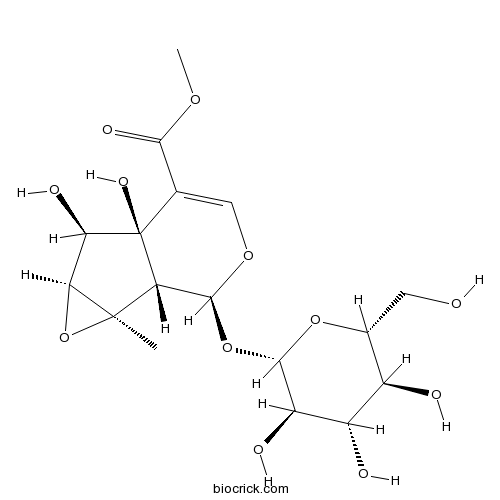Phlomis younghusbandii
Phlomis younghusbandii
1. The products in our compound library are selected from thousands of unique natural products; 2. It has the characteristics of diverse structure, diverse sources and wide coverage of activities; 3. Provide information on the activity of products from major journals, patents and research reports around the world, providing theoretical direction and research basis for further research and screening; 4. Free combination according to the type, source, target and disease of natural product; 5. The compound powder is placed in a covered tube and then discharged into a 10 x 10 cryostat; 6. Transport in ice pack or dry ice pack. Please store it at -20 °C as soon as possible after receiving the product, and use it as soon as possible after opening.
Natural products/compounds from Phlomis younghusbandii
- Cat.No. Product Name CAS Number COA
-
BCN6051
Sesamoside117479-87-5
Instructions

-
BCN4187
Shanzhiside methylester64421-28-9
Instructions

Anti-inflammatory activity of phlomisoside F isolated from Phlomis younghusbandii Mukerjee.[Pubmed: 26263166]
This study was designed to investigate the anti-inflammatory effect of phlomisoside F (PMF) isolated from Phlomis younghusbandii and to explore the possible pharmacological mechanisms. Anti-inflammatory effects of PMF were evaluated by using carrageenan-induced rat paw edema test, dimethylbenzen-induced ear edema test, acetic acid-induced vascular permeability and cotton pellet granuloma test. Furthermore, the releases of pro-inflammatory cytokines (TNF-α, IL-6 and IL-1β) were determined by ELISA. To explore the potential mechanisms, expressions of iNOS and COX-2 were determined by quantitative real-time PCR and western blotting assays. In addition, the expressions of nuclear p65, cytosolic p65, IκB, p38, p-p38, p-ERK1/2, ERK1/2, JNK and p-JNK were determined by western blotting assay. Our results indicated that PMF administered orally could not only significantly decrease rat paw edema in rats and ear edema in mice, but also reduce the vascular permeability in mice and granuloma weights in rats. In vitro, the releases of LPS-induced pro-inflammatory cytokines (TNF-α, IL-6, IL-1β) and enzymes (iNOS and COX-2) were decreased significantly by PMF treatment in RAW 264.7 cells. In addition, the LPS-induced up-regulations of nuclear p65, p38, p-p38, p-ERK1/2, JNK and p-JNK proteins in RAW 264.7 cells significantly decreased by PMF, and expressions of cytosolic p65 and IκB were obviously up-regulated after treatment with PMF. In conclusion, we suggested that the PMF is a promising potential anti-inflammatory drug, and PMF could down-regulate expressions of pro-inflammatory cytokines and mediators by inhibiting the NF-κB/MAPK pathways.
[Isolation, idetification and anti-HIV-1 integrase activity of culturable endophytic fungi from Tibetan medicinal plant Phlomis younghusbandii Mukerjee].[Pubmed: 23888705]
A total of 52 endophytic fungi were isolated from roots and stems of Tibetan medicinal plant Phlomis younghusbandii Mukerjee. These fungal isolates were molecularly identified based on ITS sequnces and 28S sequences distributed to 12 genera, including Phoma, Chaetosphaeronema, Fusarium and Leptosphaeria, etc. Among them, the dominant genus was Phoma. Extracts of all strains were evaluated for anti-HIV-1 integrase activity by using soluable integrase expressed in E. coli BL21 (DE3). The results showed that seven samples from five fungal endophytes PHY-24, PHY-38, PHY-40, PHY-51, PHY-53, which belonged to genus Chaetosphaeronema, inhibited strand transfer reaction catalyzed by HIV-1 integrase with IC50 values, of 6.60, 5.20, 2.86, 7.86, 4.47, 4.56 and 3.23 microg x mL(-1) respectively. In conclusion, the endophytic fungi of Phlomis younghusbandii Mukerjee are valuable for further screening anti-HIV-1 integrase agents.
[Determination of five iridoid glycosides in Phlomis younghusbandii by HPLC].[Pubmed: 21657079]
To develop an RP-HPLC method for the determination of five iridoid glycosides in Phlomis younghusbandii.
[Study on the chemical constituents of Phlomis younghusbandii].[Pubmed: 21548366]
To study the chemical constituents of Phlomis younghusbandii.
[Antitumor effect of phlomio1 in vivo and in vitro].[Pubmed: 20707081]
To study the antitumor effect of phlomiol extracted from Phlomis younghusbandii in vivo and in vitro. The inhibitory effect of phlomiol on two kinds of human tumor cells proliferation was assayed by MTT method. Transplant tumor models of S180 and H22 were used. After transplantation, different doses of phlomiol were given to the mice for 14 days. The inhibitory rates were calculated. MTT method was used to assess the proliferation of T spleen lymphocyte cells and the activity of NK cells in tumor-bearing mice with S180. Phlomiol (50-100 mg x L(-1)) inhibited the proliferation of three kinds of tumor cells in vitro, antitumor effect of phlomiol was in a dose-dependent manner (r = 0.989, P < 0.05). The inhibitory rates of phlomiol (2.5, 5, 10 mg x kg(-1)) were 28.5%-65.0% and 35.0%-74.5% in tumor-bearing mice with S180 and H22 respectively, It could stimulate the spleen T-cells in tumor-bearing mice with S180 and increase the activity of the NK cells. Phlomiol could inhibit the proliferation of three kinds of tumor cells in vitro, present antitumor effect on the tumor-bearing mice, and improve the immunological function.
[A new furanolabdane diterpene glycoside from Phlomis younghusbandii Mukerjee].[Pubmed: 19350823]
In order to find the compound basis of Phlomis younghusbandii Mukerjee that related to pharmacodynamic action, various chromatographic techniques were used to separate and purify the constituents of this plant, and physicochemical and spectral data were used to identify the structures of obtained compounds. A new furanolabdane diterpene glycoside, named as phlomisoside F, was isolated and identified, which was 15,16-epoxy-8(9),13(16), 14-labdatrien-7-ketone-19-oic acid-beta-D-glucopyranosyl ester.
[Studies on the chemical constituents of Phlomis younghusbandii].[Pubmed: 18300491]
To study the chemical constituents of Phlomis younghusbandii.


